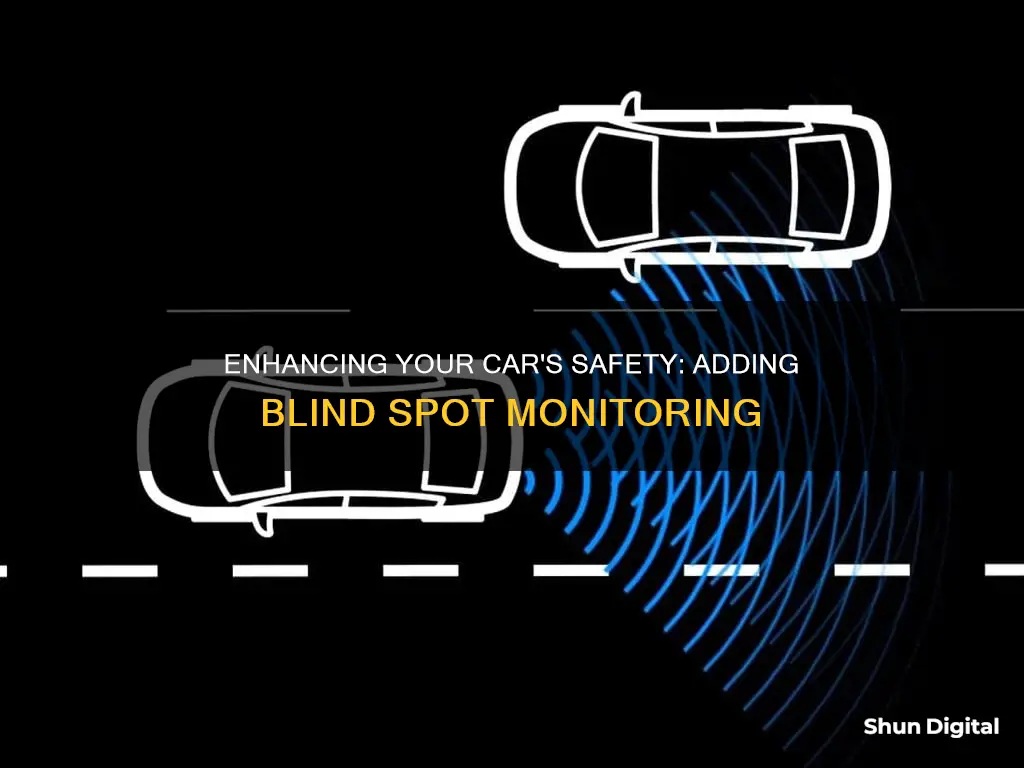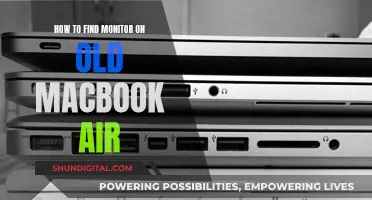
Blind spots can be dangerous, and many modern cars now come with blind spot monitoring (BSM) as standard. However, if your car doesn't have this feature, you can still add it as an aftermarket product. Aftermarket blind spot monitors use sensors or cameras to detect vehicles in your blind spots and alert you with a visual or audio warning. They can be a great way to improve safety and driver confidence, especially for larger vehicles or those with restricted visibility. While some systems can be installed yourself, others may require professional installation.
| Characteristics | Values |
|---|---|
| Purpose | Notifies the driver if another vehicle has appeared within their blind zone and is at risk of a collision |
| System | Advanced driver assistance system (ADAS) |
| Benefits | Prevents accidents, increases driving awareness, enhances driver confidence, improves all-around awareness, increases safety for vulnerable road users, and may lead to insurance discounts |
| Types | OEM (Original Equipment Manufacturer) and aftermarket BSM; sensor-based systems and camera-based systems |
| Cost | Sensor-based systems: $50-$100; Camera-based systems: $300+; Aftermarket systems: $250-$500+ |
| Installation | Professional installation recommended; wired systems require removing the bumper, wireless systems are easier to install |
What You'll Learn

Sensor-based systems
When another vehicle enters the view" of the blind spot sensor and you are travelling at or above a specific speed, the sensor triggers the indicator. This indicator is an important part of the system, as it alerts you to potential dangers. Without it, you would have no way of knowing if the sensor detected a hazard. Indicators come in many forms, but most aftermarket kits use a combination of visual LED lights and audible alarms. You can also control the volume of the indicator in many systems.
The top systems have a sensor that projects a beam that bounces back when reflecting off the surface of another vehicle. When the beam returns to the system, you receive an alert.
- Mount the sensors on the rear of your car, near the corners of your bumper, out of the way of any exhaust pipes or other obstacles.
- Route the wires from the sensors to the inside of your car. You may need to drill a small hole in the firewall to do this.
- Install the control unit, typically under the dashboard.
- Install the LED lights or other warning indicators, usually on the inside of your side mirrors.
- Connect the wires from the sensors and the control unit to the power supply in your car.
Converting an LCD TV Monitor to VGA: Easy Steps
You may want to see also

Camera-based systems
Camera-based blind spot monitoring systems use a small camera mounted on the side of the car to detect vehicles in your blind spots. They are typically more expensive and difficult to install than sensor-based systems, but they can provide a clearer view of what's in your blind spot.
When choosing a camera-based system, consider the following:
- Budget: Camera-based systems can cost upwards of $300, so be sure to compare prices and choose a system that fits your budget.
- DIY skills: Camera-based systems can be more complex to install than sensor-based systems. If you're not comfortable working on your car, consider hiring a professional to install the system for you.
- Vehicle features: Check your car's manual to see if it has pre-wiring for blind spot monitoring, which can make installation easier.
When installing a camera-based blind spot monitoring system, the process will typically involve the following steps:
- Mount the camera on the side of the car: The camera should be mounted near the side mirror or rear bumper, ensuring it has a clear view of the blind spot area.
- Connect the camera to a display: The camera feed can be displayed on your dashboard, rearview mirror, or infotainment screen. Choose a location that is easily visible without taking your eyes off the road.
- Adjust the camera angle: Ensure the camera is properly angled to capture the blind spot area effectively. You may need to test and adjust the angle to get the best view.
- Set up alerts: Configure the system to provide visual and/or audible alerts when a vehicle is detected in your blind spot. You may also be able to customize the volume and type of alert.
- Test the system: Once installed, test the system to ensure it is functioning properly. Pay attention to the alert volume and make any necessary adjustments to ensure it is noticeable but not too startling.
It is important to note that while camera-based systems can provide a clearer view, they may not always be as accurate as sensor-based systems. Additionally, the installation process can be more complex and may require professional assistance. However, camera-based systems offer enhanced visibility and can be a valuable investment for improving safety and driving confidence.
Asus vs Acer: Which Monitor Brand is Superior?
You may want to see also

Universal aftermarket blind spot monitoring systems
There are two main types of aftermarket blind spot monitoring systems: sensor-based systems and camera-based systems. Sensor-based systems use ultrasonic sensors mounted on the rear of the car to detect vehicles in the blind spots, while camera-based systems use a small camera mounted on the side of the car to provide a feed to the dashboard or rearview mirror. Sensor-based systems are generally cheaper and easier to install, but camera-based systems can offer a clearer view of the blind spot.
When choosing a universal aftermarket blind spot monitoring system, it is important to consider the accuracy of the sensors and the ease of installation. High-quality sensors will be able to detect potential dangers while ignoring false alarms, and some systems may also offer advanced features like Lane Change Assist (LCA) and Active Overtaking Alarm (AOA).
The installation process for a traditional wired blind spot monitoring system can be complicated, often requiring professionals to remove the bumper for installation. However, wireless systems can be installed more easily on the surface of the car. It is recommended to consult a professional for installation, but for those who wish to install the system themselves, here are some general steps to follow:
- Measure and mark the installation points for the sensors, ensuring they are placed correctly in relation to the vehicle's wheels.
- Clean the calibration points on the inner rear bumper.
- Place the sensors on the marked spots, using adhesive to secure them.
- Mount the LED indicators inside the cabin, ensuring they are visible without obstructing the driver's view of the road.
- Adjust the volume of the indicators to ensure they are noticeable without being startling.
Choosing the Right Size Monitor for Your Church Wall
You may want to see also

OEM blind spot monitoring upgrades
Upgrading your car to include an OEM (Original Equipment Manufacturer) blind spot monitoring system can significantly improve safety and driver confidence. These systems are designed to work with your specific car model, integrating seamlessly with your dashboard and electronics.
OEM systems use radar or cameras to detect vehicles in your blind spots, and typically alert you with a visual indicator in your side mirror or an audible warning. This can help you avoid lane change collisions, which are a common type of accident.
There are a variety of OEM blind spot monitoring systems available, including:
- Jeep Wrangler 2018-2024
- Jeep Gladiator 2020-2024
- Ram Truck 1500 2019-2024
- Ram Tuck 2500-3500 2019-2022
These systems offer a range of benefits, including enhanced safety, improved driver confidence, and seamless integration. They are designed to work with specific car models, ensuring optimal performance and a perfect fit.
In addition to the above options, it is also possible to install aftermarket blind spot monitoring systems, which are more affordable and universal, working with any vehicle regardless of age, make, and model. However, OEM systems offer superior performance and integration, making them a preferred choice for those seeking to upgrade their vehicles with advanced safety features.
The Monitor Resolution Debate: 1080p vs 1440p for the Ultimate Experience
You may want to see also

Installation considerations
If you're installing an aftermarket blind spot monitoring system yourself, be sure to carefully read the instructions that come with the system. You will also need to purchase some additional tools, such as a drill and a wire cutter.
- Mount the sensors on the rear of your car, near the corners of your bumper, and away from any exhaust pipes or other obstacles.
- Route the wires from the sensors to the inside of your car. You may need to drill a small hole in the firewall to do this.
- Install the control unit under the dashboard.
- Install the LED lights or other warning indicators. These are typically mounted on the inside of your side mirrors.
- Connect the wires from the sensors and the control unit to the power supply in your car.
Installing a camera-based system is a more complex process and is best left to a professional.
The installation of traditional wired blind spot monitoring systems is extremely complicated and often requires professionals to remove the bumper of the car. Wireless systems, on the other hand, can be installed on the surface of your car.
If you have any questions or issues during the installation process, reach out to a service centre to have a professional take over.
Ultimate Guide to Buying a 360Hz Monitor
You may want to see also
Frequently asked questions
A blind spot monitor is an advanced driver assistance system (ADAS) that notifies the driver if another vehicle has entered their blind zone and is at risk of a collision.
A blind spot monitor uses sensors or cameras to detect vehicles in a car's blind spots. When a vehicle is detected, the system alerts the driver through an audible and/or visual warning.
Blind spot monitors can be installed by a professional or as a DIY project. The process involves mounting sensors, routing wires, installing control units and LED lights, and connecting wires to the power supply.







